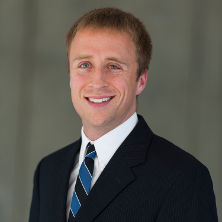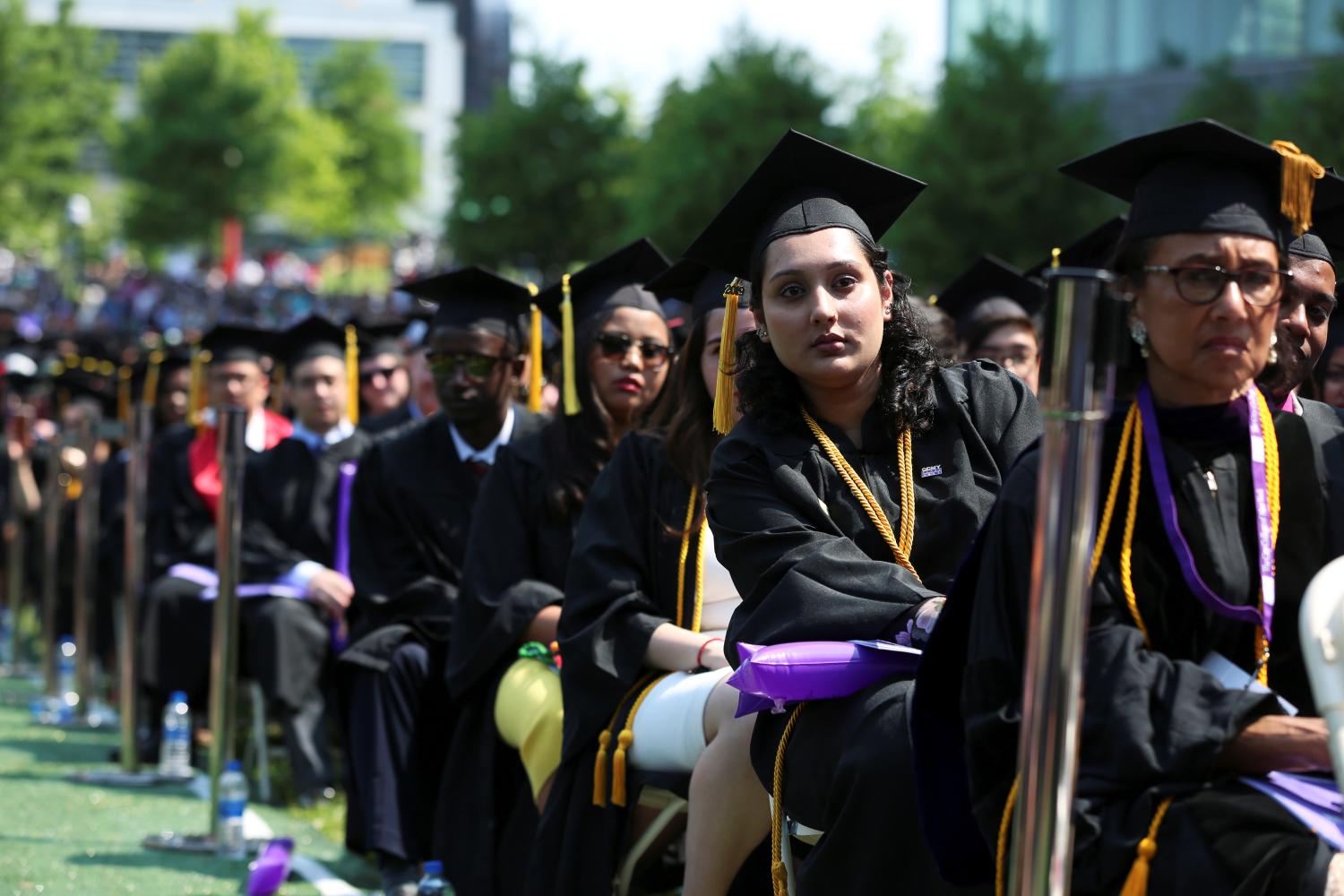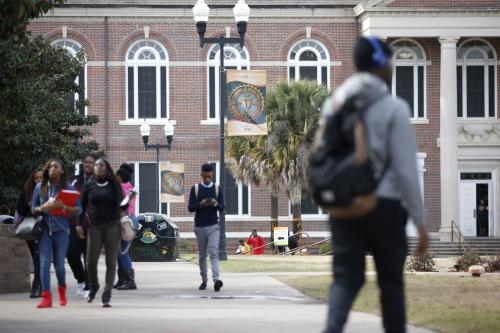This paper was written in conjunction with the Accountability in higher education event on September 8, 2020.
There are growing concerns about the financial stability of much of the American higher education system. The number of high school graduates is expected to decline nationally over the next decade. These declines are forecast to be particularly large in the Northeast and Midwest, two areas that are home to a large share of private nonprofit colleges (Grawe, 2018). There is also skepticism about the value of higher education from many individuals amid rising student loan debt and pressures to hold colleges more accountable for their students’ outcomes (Kelchen, 2018b). The growing partisan divide in public perceptions of higher education (Parker, 2019) could also threaten the viability of some struggling colleges. Finally, massive losses to the higher education industry as a result of the coronavirus pandemic of 2020 threaten to deplete the resources of colleges that were in reasonable shape prior to the pandemic and ensuing recession.
All of the above factors have led to greater attention being paid to college closures. Although college closures have existed throughout the history of American higher education (e.g., Tewksbury, 1932), the issue gained national prominence in the 2010s. Credit ratings agency Moody’s prominently predicted in 2015 that the number of private nonprofit colleges closing each year would double within the next three years (Woodhouse, 2015), while Harvard professor Clayton Christensen has repeatedly forecasted that half of all colleges will close within the next ten to fifteen years (Hess, 2018).
While the rate of college closures is currently falling short of Christensen’s well-publicized predictions, there have been a number of prominent closures and near closures over the last few years. These closures have been limited to private for-profit and nonprofit colleges, as public colleges typically are involved in mergers instead of closures. In the for-profit sector, several large chains such as Argosy University, Corinthian Colleges, ITT Tech, and Vatterott College have collapsed since 2012. None of the nonprofit colleges that have closed during this time are of the size of the large for-profit chains, but closures (such as the College of New Rochelle and multiple colleges in Vermont) and near-closures (such as Hampshire College and Sweet Briar College) have garnered substantial attention.
In an ideal world, a college would announce its closure with enough time for current students to finish their studies at that institution or at another college that has agreed in advance to accept those students and help them complete in a timely manner (something that is known as a teach-out agreement). Closures of private nonprofit colleges occasionally occur in this manner, but many closures happen with much less notice. If a college collapses overnight without a teach-out agreement in place, as often happens in the for-profit sector, students are left scrambling without guidance from their institution.
Abrupt college closures have negative impacts on both students and taxpayers. Students who attend a college that closes abruptly have two potential options. They can try to complete their studies at another college, which may require them to repeat a number of courses if a teach-out agreement is not in place. Alternatively, they can apply for a closed school discharge from the U.S. Department of Education (Office of Federal Student Aid, n.d.a.), which forgives the loans of all students who were enrolled within 120 days of the college closing without completing a credential but also forces them to restart their studies from scratch at another institution.[1] When students apply for closed school discharges, the bill effectively gets passed to taxpayers. In the last several years, the federal government has forgiven at least half a billion dollars in loans after several large for-profit college closures (Kreighbaum, 2019).
To reduce the risk to taxpayers and to protect students, the federal government requires colleges to be financially sound in order to receive federal financial aid dollars. Private colleges (both for-profit and nonprofit) must receive a passing score on a financial responsibility metric to receive federal aid, with low-performing colleges being required to post a letter of credit with the U.S. Department of Education in order to keep aid eligibility. A poor financial responsibility score is one of the factors that can place a college under Heightened Cash Monitoring (HCM), which in its most severe form may require institutions to be reimbursed by the federal government after disbursing aid to students (Office of Federal Student Aid, 2019a). However, this current system has both failed to identify a number of colleges that closed and contributed to the collapse of other colleges by restricting their access to credit (Blumenstyk, 2014).
These concerns have led to efforts by a number of different agencies and organizations to better identify colleges at risk of closure and intervene in ways to protect students and taxpayers. Private colleges are overseen by a regulatory triad of state authorizing agencies, accrediting bodies, and the federal government (Tandberg, Bruecker, & Weeden, 2019), and each of these groups is taking actions. For example, the Massachusetts Board of Higher Education (2019) has proposed regulations that would oversee the financial health of private nonprofit colleges and identify institutions it sees at risk of closure within the next 18 months, and the state’s House unanimously passed legislation requiring the board or the college’s accreditor to do annual financial reviews (Schoenberg, 2019). Both the U.S. Department of Education and members of Congress are working to update financial requirements for colleges and place additional responsibilities on accrediting agencies (Busta, 2019). Finally, there are a growing number of efforts by private organizations and researchers to judge colleges’ financial viability (Carlson, 2020).
While it is important to both students and taxpayers to identify colleges at risk of closure to either begin an orderly ending of operations or to help avoid closure, one challenge of these efforts is the fear of a self-fulfilling prophecy if students no longer consider attending a college that is financially unstable, hastening the institution’s demise. This concern has led some private colleges and advocacy organizations to push back against the proposed Massachusetts regulations (Seltzer, 2018; Sullivan & Stergios, 2019) and was one reason why the U.S. Department of Education historically did not release the names of colleges under additional financial oversight (Stratford, 2015). This means that any efforts to identify colleges at risk of closure must be as accurate as possible to avoid false positives, especially as a large percentage of colleges that were identified as being at risk of closure decades ago have remained open today (Tarrant, Bray, & Katsinas, 2018).
In this paper, I used publicly available data on institutional finances and other characteristics to predict the probability of closure two and four years later among private nonprofit and for-profit colleges. To briefly preview my results, I found a number of characteristics that are associated with college closures for both sectors of higher education. However, while I was able to identify colleges at relatively high risk of closure, only a small fraction of these high-risk colleges ended up closing. This suggests that the predictive power of data elements that are widely available across colleges is relatively weak. This highlights the need for the federal government, accrediting bodies, and state authorizing agencies to collect better data on factors that may better predict closure.
Read the paper here.
The author did not receive financial support from any firm or person for this article or from any firm or person with a financial or political interest in this article. He is not currently an officer, director, or board member of any organization with an interest in this article.





